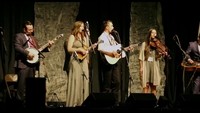
Flatt Lonesome’s fourth album Silence in These Walls continues the winning streak for this six piece Americana act specializing in bluegrass and country music. Their songwriting mood is never limited, veering from despair to moments of genuine exaltation, and the depth of each collection from this critically lauded outfit continues to deepen with each new studio release and the band continues to show a penchant for following their own songwriting muse over outside material. You can definitely chart the upward tick in the band’s confidence and they’ve now reached what it isn’t any stretch to deem the first likely peak of the band’s career. It makes sense. The third and fourth albums are often where the truly distinguished units have gathered the full force of their artistic powers and get their potential over in a way previously out of reach. Silence in These Walls will likely be a defining release for Flatt Lonesome’s life as a band and is certain to entertain a vast swath of the listening public.
URL: http://flattlonesome.com/about/
The opening track “All My Life” brings blues and bluegrass together with some of the classic harmony vocals so common in country and bluegrass music alike. It’s definitely an unhappy, brooding song, but presented with a upward lift that never settles for any sedate rendering of the song’s emotions. The instruments are recorded with a crispness that sparkles brightly providing a good contrast with Kelsi Robertson-Harrigill’s vocals. The elegiac fiddle weaving its way through “It’s Just Sad” gives the performance much of its melodic signature and Charli Robertson’s singing is particularly focused and lyrical sounding. There’s definitely a throwback feel consuming songs like this that Flatt Lonesome, nonetheless, handles artfully and without any hint of naked imitation.
“I’m Not Afraid to Be Alone” returns to the architecture making the first song so successful and it deserves consideration as one of the album’s best songs. The rich harmony singing is a stalwart strength of the style and Flatt Lonesome makes memorable magic with these moments thanks to the bluesy strains coloring the delivery. There’s a bluesy edge shading the music as well but, unlike the opener, it embraces the acoustic guitar and a nominally simpler approach than the tightly woven bluegrass runs of the first song. “Where Do You Go” has immense stylishness apparent from the beginning and the quasi-exotic feel of the opening guitars has an almost classical flair. It transitions into a much more straight forward bit of singer/songwriter artistry driven by acoustic guitars and benefitting from some lightly stated harmonies. The song is a cover of a Glen Campbell tune dating back to 1970. “Happy Till He Comes” has a jaunty optimism brimming from its instruments and Robertson-Harrigill’s vibrant vocal in the first verse and Charli Robertson’s in the following verses. This is a very inspirational song speaking to a personal faith that believes, no matter what trials, there’s personal satisfaction to be derived from holding on to your beliefs with the knowledge of a better day to come. There’s a pleasant amount of playfulness coming through on a performance like this as well that many listeners will enjoy. Buddy Robertson’s nasal twang is ideally suited for music like this and his presence on the cover “You’re The Reason” brings this country classic back to vivid life. Flatt Lonesome’s personal take on its musical character proves to be mightily entertaining. It ends Silence in These Walls on a very bright, joyful note and is the last evidence we need of the increasing confidence that makes every new release better than the last.
I-TUNES: https://itunes.apple.com/us/album/silence-in-these-walls/id1264306073
Jason Hillenburg
